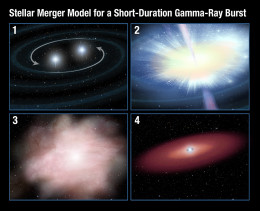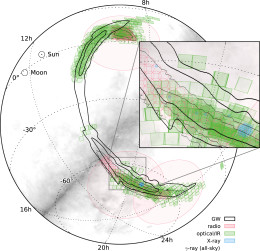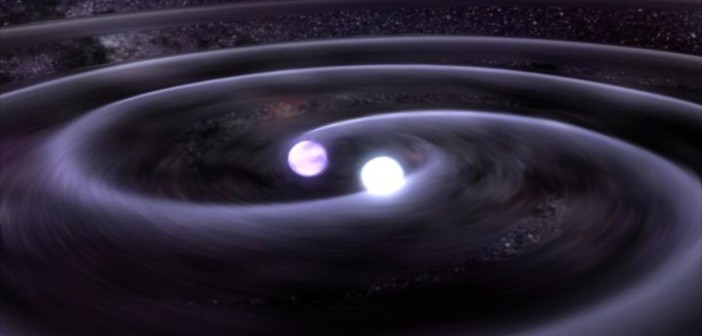On 14 September 2015, the Laser Interferometer Gravitational-wave Observatory (LIGO) — in a pre-operative testing state at the time — detected its first sign of gravitational-waves. The LIGO team sprang into action, performing data-quality checks on this unexpected signal. Within two days, they had sent a notification to 63 observing teams at observatories representing the entire electromagnetic spectrum, from radio to gamma-ray wavelengths.

Illustration of a binary neutron star merger. The neutron stars 1) inspiral, 2) can produce a short gamma-ray burst, 3) can fling out hot, radioactive material in the form of a “kilonova”, and 4) form a massive neutron star or black hole with a possible remnant debris disk around it. [NASA/ESA/A. Feild (STScI)]
What were they looking for?
As two compact objects in a binary system merge, the system is expected to emit energy in the form of gravitational waves. If both of the compact objects are black holes, we’re unlikely to see any electromagnetic radiation in the process, unless the merger is occurring in an (improbable) environment filled with gas and dust.
But if one or both of the two compact objects is a neutron star, then there are a number of electromagnetic signatures that could occur due to energetic outflows. If a relativistic jet forms, we could see a short gamma-ray burst and X-ray, optical, and radio afterglows. Sub-relativistic outflows could produce optical and near-infrared signals, or a radio blast wave.

Timeline of observations of GW150914, separated by wavelength band, and relative to the time of the gravitational-wave trigger. The top row shows LIGO information releases. The bottom four rows show high-energy, optical, near-infrared, and radio observations, respectively. Click for a closer look! [Abbott et al. 2016]
Surprise Signal
Since LIGO and Virgo (LIGO’s European counterpart), were primarily expecting to detect binaries involving neutron stars, they set up a notification system to be able to quickly alert electromagnetic observatories of a gravitational-wave detection. Those observatories would then be able to follow up on the gravitational-wave detectors’ rough localization, with the goal of detecting the source by its electromagnetic signature.
Given that LIGO had only just come online for testing when GW150914 was detected, it’s impressive that the pipeline was ready and there were observatories able to follow up so quickly! When the alert went out, 25 teams responded, mobilizing satellites and ground-based telescopes spanning 19 orders of magnitude in electromagnetic wavelength.
The Search Party
The only information the teams were initially given was the localization of the signal to roughly 600 square degrees on the sky. With this starting point, over the next three months, these 25 facilities carefully observed the entirety of the estimated localization area.

Footprints of observations in comparison with the initial LIGO localization of GW150914 (black contours). Shown are radio fields (red), optical/infrared fields (green), and X-ray fields (blue circles); not shown are the all-sky Fermi GBM, LAT, INTEGRAL SPI-ACS, and MAXI observations. [Abbott et al. 2016]
For the transient sources that were found, follow-up spectroscopy and further photometry was performed, to determine if the transient could have been the source of the detected gravitational waves.
What Was the Outcome?
No electromagnetic counterpart to GW150914 was found. It turns out this isn’t surprising; GW150914 was later determined to have been the merger of two black holes, which should not generate an electromagnetic signature.
So why report on this? In the publication prepared jointly by LIGO, Virgo, and these 25 teams (with one of the longer author lists you’re likely to encounter!), the authors emphasize not the conclusion, but the process leading to it.
In spite of the fact that LIGO had not yet even begun its first observing run, the alert system worked, and the community mobilized to cover the entire 600 square degrees of sky with observations and follow-up characterization of candidate sources. If all this can be accomplished for an unexpected signal, imagine how well the system will work for future detections during actual science runs! With any luck, we’ll be identifying the electromagnetic counterparts to gravitational-wave sources soon.
Citation
B. P. Abbott et al 2016 ApJ 826 L13. doi:10.3847/2041-8205/826/1/L13


2 Comments
Pingback: Predicting 2017: A Look At Humanity’s Future in Space
Pingback: A Look At Humanity's Future in Space